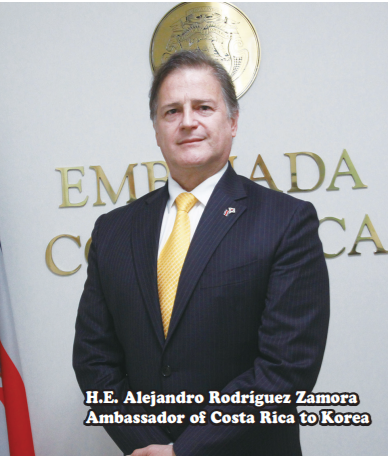
Costa Rica is a second central American country to enter into a Free trade Agreement with Korea and aspires to be known as the "Korea of Central America" as the President of Costa Rica mentioned in his speech last year. On the special occasion of bicentennial celebration of Independence Day of Costa Rica, September 15, the "Seoul City" magazine had an exclusive interview with H.E. Alejandro Rodríguez Zamora as follows.
Please introduce the significance of the Independence Day, September 15th along with your Excellency’s message on the special day to our readers.
In my capacity of Ambassador of Costa Rica to the Republic of Korea, it is a great honor to address tothe distinguished readers of the magazine “Seoul City”, regarding the significance of the celebration of the Independence of Costa Rica and other issues related to bilateral trade and investment opportunitiesas well as tourism attractions offered by Costa Rica to the Korean population.
With respect to theCosta RicanIndependence Day, it is relevant to point out that this year celebration is of particular significance for Costa Rica because we are celebrating 200 years of independence. This bicentennial celebration of our independence forces us to think about what we have achieved in the past as a nation, and what path we have to follow in the future in order to guarantee better living conditions and prosperity for our people.
Since the very beginning as a free country, after signing the Act of Independence on September 15th1821, Costa Rica has been renowned for its institutional vocation and for its strong commitment to the recognition and respect of civil liberties, property and other legitimate national rights of every person and nation.
Costa Rica strongly believes in the construction of peace and harmony as essential factors to achieve and promote social and economic development. In that regard, Costa Rica adopted an important decision in 1949, when the national army was constitutionally abolished. As a result, the scarce resources of the nation, were dedicated to strengthening the educational system, to building up a strong health infrastructure, and to supporting the welfare of the majority of the population rather than nurturing an army as an institution.
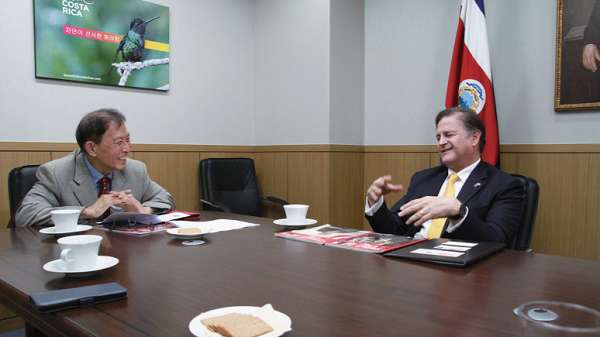
Another fundamental Costa Rican characteristic is its commitment to the rule of law. The country is convinced that the most effective mechanism to resolve international disputes and disagreements is the respect and observance of the International Law. During its 200 years of independent existence, Costa Rica has consistently defended its own sovereignty as well as universal values and principles based upon the unwavering adherence to International Law and respect of the decisions adopted by international courts of law with jurisdiction on the relevant issues. As a nation, we firmly believe in negotiation, arbitration and jurisdictional processes, and we have vigorously supported the cause of disarmament, particularly in the nuclear context.
The promotion and respect of Human Rights is in the bloodstream of the Costa Rican identity. As an illustration of such commitment to the defense and respect for Human Rights, in 1869 Costa Rica declared that primary education was free and mandatory. In addition, in 1882 the death penalty was abolished by the Constitution. It is worth noting that, Costa Rica was among the countries that unconditionally adopted the Universal Declaration of Human Rights in 1948, and it is a party to the principal international instruments on this matter. The American Convention on Human Rights was signed in our capital city of San José and the Inter-American Court of Human Rights has its seat in San José. Costa Rica has faithfully advocated in the international arena for the defense of fundamental rights and liberties and has actively promoted the creation of the United Nations High Commissioner for Human Rights.
Costa Rica has also undertaken a serious commitment to protect the environment and its biological diversity. National parks and protected areas constitute approximately 25 % of our national territory. Moreover, Costa Rica places great importance on the fight against climate change and environmental deterioration. For instance, The High Ambition Coalition (HAC) for Nature and People, was recently launched by Costa Rica along with France and the United Kingdom, in order to reverse the severe trend of biodiversity loss and revive natural 90 Executive Vice Chairman Choe Nam-suk and H.E. Alejandro Rodríguez Zamora smile during the interview ecosystems that are critical to species and humans’ survival. Specifically, the High Ambition Coalition for Nature and People, seeks the protection of at least of 30% of the world’s land and marine areas by 2030, in line with scientific advice.The President of Korea Mr. Moon Jae-in announced, during the opening ceremony of the P4G Summit, the adherence of Korea to this important initiative.
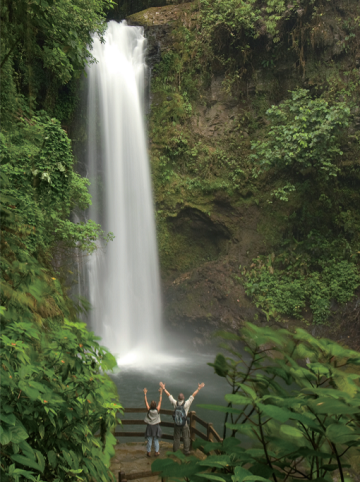
With respect to recent public policies, it is relevant to make reference to the recent acceptance of Costa Rica as the 38th member of the Organization for Economic Cooperation and Development (OECD). In fact, as a result of a joint effort made by the Government of Costa Rica along with the Legislative Assembly (the Costa Rican Congress), on May 25th 2021, Costa Rica finalized the formal process to become an official member of the OECD. During such a process, Costa Rica achieved major reforms in record time. Additionally, Costa Rica has realized the importance of learning from international best practices and the benefits of incorporating them into its public policy management to improve the living conditions of its population and in general to promote social development, economic growth, and prosperity.
In the international organizations in which Costa Rica participates, the country has consistently adhered to the principles that have given a unique identity to its foreign policy. Convinced of the importance of multilateralism as a valuable tool to promote peace and international cooperation to foster prosperity among nations, Costa Rica has been highly active in the multilateral scenario, advocating for several international initiatives to respond to global challenges.
In this historical context, it is worth noting that during these 200 years of independent existence, Costa Rica has demonstrated to the whole world that it is possible to live in peace, freely and democratically, with a strong commitment to fight against climate change and environmental deterioration. We have achieved such standards, in spite of the global challenges and the social and economic hurdles that we have faced during our existence as a nation.
For the future Costa Rica proposes 91 La Paz Waterfall to undertake its third century of independent life with the conviction of contributing with new initiatives reflecting the same values that we have adopted in the past, responding to the changing needs of our world, and resolving the new challenges with enthusiasm, responsibility, and a sense of innovation.
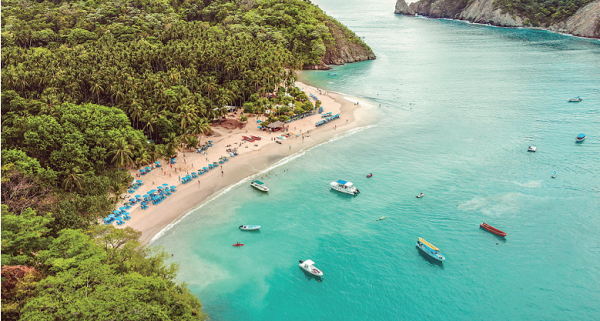
Please introduce prevailing industry and unique products of Costa Rica.
Perhaps when we ask about what products Costa Rica has to offer to the Korean market, for the majority of Korean people it will come into their minds the aromatic and tasteful Costa Rican coffee. Consequently, they may think that Costa Rica is essentially an agricultural country. On this issue, I would like to illustrate that the highquality Costa Rican coffee, and other agricultural products, are very important products that we successfully export worldwide, but, as of today,medical equipment and medical devices are the most relevant export products of Costa Rica in terms of its export share worldwide.
The aforementioned statement is to illustrate that Costa Rica has a relevant number of export products to offer to the Korean market in different sectors, including: i-Livestock and fisheries (beef, shrimps, frozen fish, poultry, powder milk); ii-Agriculture (bananas, pineapple, coffee, ornamental flowers); iii-Food (sugar, chocolate, sauces, fruit juices); iv-Chemicals and pharmaceuticals (medicines, cleaning products), v-Leather (raw leather); viElectrical and electronic parts (electrical plugs, electronic parts, radio and TV parts); vii-Medical equipment and medical devices (dental equipment, and medical prosthesis, precision equipment).
The promotion of trade between Costa Rica and Korea is an important component of ourcurrent bilateral agenda.Therefore, Costa Rica is willing to enhance its ties of mutual cooperation with Korea with the purpose of improving trade between both countries taking advantage of the current Free Trade Agreement between Korea and Central America.The aforementioned Free Trade Agreement, which entered into full force and effect this year, regulates the commercial relationshipof Korea with Costa Rica, El Salvador, Honduras, Nicaragua and 92 Tortuga Island Panamá, regarding the facilitation of market access, rules of origin, custom procedures and trade facilitation, dispute settlement, institutional provisions, trade remedies, public procurement, sanitary and phytosanitary measures, technical barriers to trade, services and investments, labor and environment, intellectual property and cooperation.
The Free Trade Agreement between Korea and Central America is a valuable tool to promote trade and commercial exchange, but it is also a tool to enhance industrial cooperation, joint ventures, investment, ties, and alliances among Korean and Costa Rican small and medium enterprises which may generate new jobs, increase the productivity, and raise new opportunities of entrepreneurship.
From the side of Costa Rica, international trade is an important factor of its public policy aimed at promoting economic growth and development. For that reason international trade is a key factor in the diversification of the Costa Rican economy, generating employment and enhancing the opportunities for the Costa Rican population.
What do you think would be the most attractive industrial sector for Korean companies to invest in Costa Rica?
Before answering to this question, I would like to make reference to 5 important factors that any potential Korean investor should know about Costa Rica:
i-In Costa Rica there are 250 hightech companies, 21% of Fortune 100 companies have established successful operations in the country;
ii-Multinationalcompanies are able to leverage specialization: Costa Rica is the #1 exporter of high-value added services and #1 in production process sophistication in Latin America;
iii-Costa Rica offers an increasing productivity that allows companies to grow with the right talent. We have highly qualified human resources, welleducated young labor force, one of the best educational system in Latin America, one of the highest English proficiency in Latin America, and an impressive increase in university graduates.
iv-Costa Rica has a privileged location, ideal for reaching the Americas and the World;
v-Costa Rica’s political stability, innovation and a proven international competitiveness provide the right climate for success.
Costa Rica has a lot to offer in terms of investment opportunities for international companies seeking new locations to expand their business. In that regard I see opportunities in different sectors such as services, advanced manufacturing, life science, food industry and light manufacturing.
In the case of Korea, I think that the most attractive industrial sector for Korean companies to invest in Costa Rica, would be the life science sector. As an illustration, during the course of the present year, I visited some medical device companies in Gangwon province, in Korea, and I perceived a potential for such companies to make investments in Costa Rica, in light of the advantages that Costa Rica can offer in terms of attracting foreign investments, particularly the highly qualified young human resources and the sophistication achieved by Costa Rica in the area of medical equipment and medical devices export products (dental equipment, and medical prosthesis, precision equipment). In addition, the Korean companies may export their technology by using Costa Rica as a platform to expand the presence of their medical device products in the Latin American markets, and even they may take advantage of the current Free Trade Agreements subscribed by Costa Rica with different counties and regions, such as the US-DR CAFTA.
Currently we have important investment of Korean companies in Costa Rica such as Daewoo Bus, in the sector of bus manufacturing and SAE-A Trading Co Ltd, in the sector of textiles. Sae-A, Korea's largest global apparel manufacturing and export company, officially began bulk production at its satate-of-the-art cotton spinning mill in Costa Rica in 2015. “Sae-A is hornored to welcome President Luis Guillermo Solis and Mininster Welmer Ramos Gonzales of the Ministry of Ecomomy, Industry and Commerce to celebrate the opening of the first spinning mill in Costa 93 Rica” said Sae-A ChairmanWoongki Kim. “Sae-A Spinning will create tremendous opportunites for existing and new businesses across the region. Our commitment to the people of Costa Rica is unwavering and we look forward to continued growth in the coming months and years.”
Costa Rica is a worldwide renowned tourism destination. We have a lot to offer in terms of tourism attractions, from beautiful sandy beaches and luxurious resorts in the Pacific and in the Atlantic coast line, paradisiac islands, beautiful mountains, active volcanos,incredible hot springs, to bucolic coffee farms in the scenic mountains and colorful valleys.
However, what have differentiated us from other tourism destinations is the ecotourism, one of the key activities of the tourism industry of Costa Rica. Actually Costa Rica is recognized as one of the pioneer in this sector and one of the few true ecotourism destinations. Ecotourism attract a large number of tourists interested to visit the extensive national parks and protected areas as well as to explore the great biological diversity (flora and fauna) host by the Costa Rican territory. As I mentioned before, national parks and protected areas constitute approximately 25 % of our national territory.
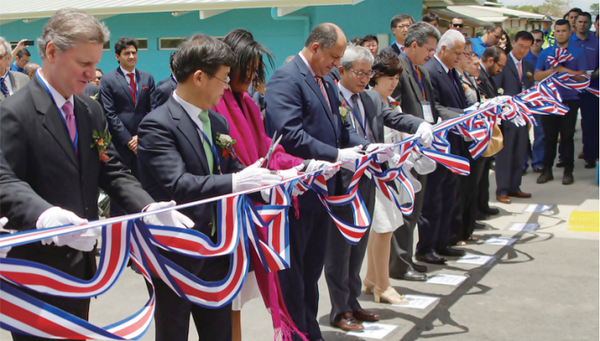
Please let us know your point of view on how to strengthen further the close cultural educational ties between the peoples of Costa Rica and Korea in the years to come.
Costa Rica is a worldwide renowned tourism destination. We have a lot to offer in terms of tourism attractions, from beautiful sandy beaches and luxurious resorts in the Pacific and in the Atlantic coast line, paradisiac islands, beautiful mountains, active volcanos,incredible hot springs, to bucolic coffee farms in the scenic mountains and colorful valleys.
However, what have differentiated us from other tourism destinations is the ecotourism, one of the key activities of the tourism industry of Costa Rica. Actually Costa Rica is recognized as one of the pioneer in this sector and one of the few true ecotourism destinations. Ecotourism attract a large number of tourists interested to visit the extensive national parks and protected areas as well as to explore the great biological diversity (flora and fauna) host by the Costa Rican territory. As I mentioned before, national parks and protected areas constitute approximately 25 % of our national territory.
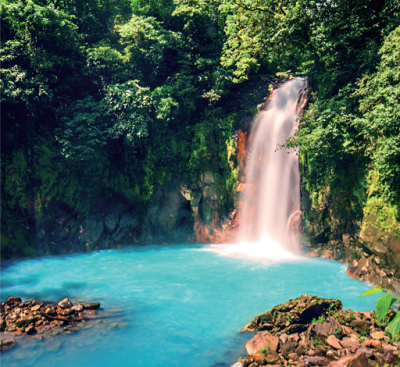
Please let us know your point of view on how to strengthen further the close cultural educational ties between the peoples of Costa Rica and Korea in the years to come.
Costa Rican people admire very much Korea, a nation that has faced may challenges in the past but that has been able to build up a prosperous society, with an exceptional future for its population.
Nowadays anincreasing number of Costa Rican young people is following very closely contemporary Korean arts and culture, which have accomplish global recognition because of the quality, creativity and sound groundwork involved in every performance and 94 Sae-A Spinning is holding a ribbon-cutting to officially open the Sae-A Spinning S.R.L. Beginning third from the left, Cheryl Mills, Counselor and Chief of Staff for former Secretary of State to the United States (2009-2013) and Founder of Blacklvy Croup; Luis Guillermo Solis, Costa Rican President; and Kim Woong-ki, Sae-A Trading Co. Ltd Chairman are pictured. every work. Costa Rica, as the rest of the world, is witnessing how the Korean talent is shining in visual arts, performing arts, popular music, and fashion industry, among others. The tendencies and taste derived from such cultural and art manifestations are going beyond the Korean frontiers.
As a result of these cultural ramifications derived from visual arts, performing arts, popular music and fashion industry, there are many Costa Rican young people willing to come to Korea to pursue their academic goals and objectives as well as to have close contact with the Korean culture and arts.
In the same way, I am sure that a number of Korean young people is willing to learn Spanish language from academic and university institutions in Costa Rica while having the Costa Rican cultural exposure. I would like to mention that a group of Korean students are enrolled in some of the academic programs offered by the University for Peace (UPEACE), an institution of higher education dedicated to the study of peace, created by the United Nations General Assembly and whose Main Campus is located in San José, the capital city of Costa Rica.
In that respect, I firmly believe that one way to further the cultural ties between the people of Costa Rica and Korea is precisely throughout academic exchanges. Furthermorethe promotion of academic programs and scholarships from Korean Universities on behalf of more Costa Rican students and vice versa could contribute a great deal with such an objective.
Needless to say, the increase of trade between Costa Rica and Korea as well as the increase of Korean Investment in Costa Rica will naturally foster the cultural ties between our two nations that historically have developed a very strong sense of friendship, mutual respect and mutual cooperation.
The Embassy of Costa Rica in Seoul is actively promoting cultural exchanges and vigorously developing long lasting relationship and strong ties with culture associations and Korean institutions whose objectivesare related to the promotion and enhancement of cultural ties of Korea with other countries and nations. The same effort is made in connection with local governments and organizations of local government where we continuously explore and promote exchanges and sisterhood agreements between Korean local governments and Costa Rican local governments. These are other ways to strengthening cultural educational ties between the peoples of Costa Rica and Korea.
Moreover, once the COVID-19 pandemic is under control, the Embassy of Costa Rica in Korea will resume the artistic exchanges between Korea and Costa Rica, throughout the promotion of visits of Costa Rican artists and dancing folklore groups to Korea and vice versa.

